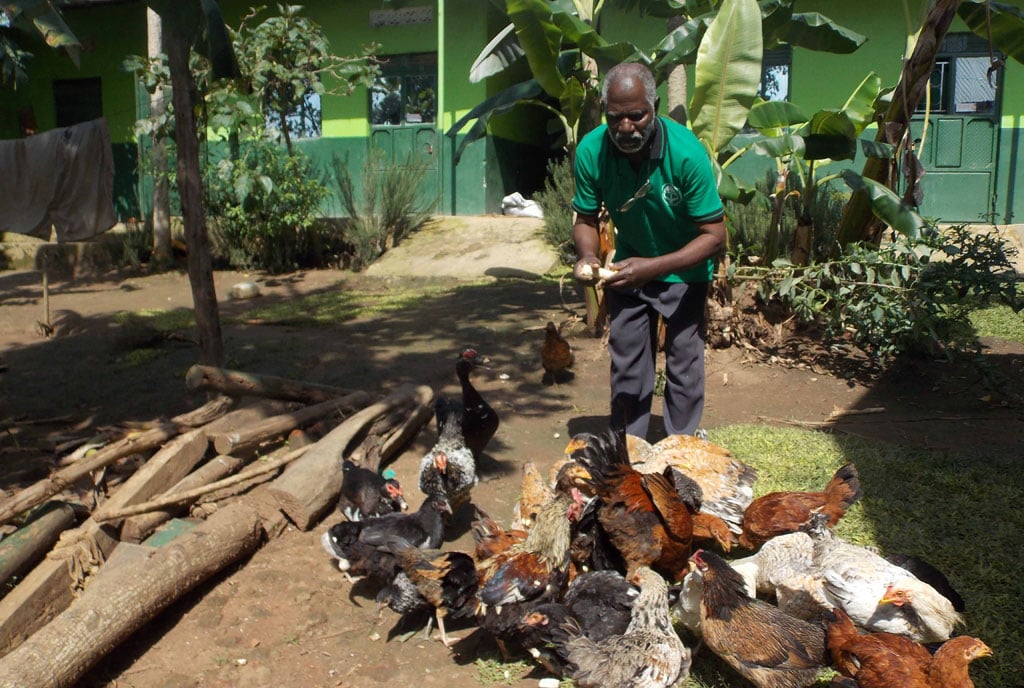Prime
This is why paraffin is good for chicks

A farmer in his chicks. Photo/File
What you need to know:
- Medicinal liquid paraffin, also known as paraffinum liquidum, is a highly refined mineral oil used in cosmetics and for medicinal purposes. This product should not be confused with the paraffin (kerosene) used as fuel.
In the story on my poultry venture recently, I had recounted how I offer liquid paraffin to my chicks.
This generated a lot of concern from readers including Dr Isaac Kipsang of Egerton University in Kenya.
Dr Kipsang posed; is this not harmful to the chicks? What constitutes paraffin? Has this been scientifically proven to aid in digestion? After maturity can the chicken be stewed and enjoyed at the dinner table.
All about paraffin
After hatching chicks, I normally transfer them to the deep litter brooder and provide supplemental heat using ordinary light bulbs.
During the first one week, I provide chick formula (to boost immunity), glucose (for energy), and liquid paraffin to clear the digestive system.
Chick formula contains vitamins and antibiotics.
Medicinal liquid paraffin, also known as paraffinum liquidum is a highly refined mineral oil used in cosmetics and for medicinal purposes. This product should not be confused with the paraffin (kerosene) used as fuel. Liquid paraffin is found in agrovets and retails at about Shs3,600 per 100ml.
Healthy chicks
Liquid paraffin of mineral oil is a transparent, colourless, odourless, oily liquid composed of saturated hydrocarbons obtained from petroleum.
When put in water it does not mix but floats on the surface making it easy for the chicks to ingest it.
In humans, liquid paraffin is used as a laxative (stool softener) to guard against constipation and for softening dry skin. The use of petroleum as medicine dates back to at least 400 years BC.
The earliest internal use of refined petroleum dates 1872 when Robert A. Chesebrough was granted a patent for the manufacture of ‘a new and useful product from petroleum.’
The use of liquid petroleum gained popularity after Sir W Arbuthnot Lane chief surgeon of Guy’s Hospital, UK, in 1913 recommended its use as a treatment for intestinal stasis and chronic constipation. Since then, liquid paraffin, has been used to treat constipation particularly in children.
Chick formula
Apart from liquid paraffin, chick formula and glucose, other measures are necessary to keep the chicks healthy.
First, to minimise losses, pre-heat the brooder for six hours before transferring the chicks from the hatchery.
Crowding around the source of heat is often a sign of low temperature. If the chicks move away from the heat source, this may indicate high temperatures.
I feel comfortable when the chicks are evenly distributed in the brooder, active and moving about.
Extremes of temperature, too high or too low is dangerous to the chicks. Apart from inadequate heating or too much of heat in the brooder mortality during the first week of the chick’s life may be related to the quality of the hatched birds.
I always check for the novel infection associated with unabsorbed yolk and ascertain the chicks are active, clean and dry and the eyes are open and alert.
It is inadvisable to buy eggs to hatch or even mature birds if you are not sure of the source.
Second, use the right feeds and ensure they are of good quality. I feed chick mash from day one to week eight, growers mash week nine to 18 and thereafter, start on the layers mash.
Vaccinate regularly
Third, ensure adequate supply of clean water and maintain a ratio of one drinker for 50 chicks.
Fourth, give the necessary vaccines as per recommended schedule. For improved indigenous birds, I give gumboro at day 10 and day 18 in drinking water. I administer the first New Castle Vaccine (NCV) at week three, week eight and the third dose at point of laying either as eye drops or in water. Thereafter, I repeat NCV every three months. Fowl pox is administered at week three and six as a wing web stab. Make sure you buy a special needle for this.
Fowl typhoid vaccine is given as an intramuscular injection at week eight. De-worming is done at week 19 and repeated every three months.
Only buy vaccines from reputable sources where you are sure of their cold chain management system.
Use a cool box to carry the vaccine home and administer immediately. Do not buy vaccines to keep in the house even if you own a fridge because you have no control over prolonged blackouts.
Once reconstituted, give the vaccine within three hours. Do not use chlorinated tap water to reconstitute the vaccine because this destroys it. If using tap water, stand overnight to inactivate the chlorine or use water purifier.





